Delhi, the capital of India has a strong historical background. It was ruled by some of the most powerful emperors in Indian history. The history of the city is as old as the epic Mahabharata. The town was known as Indraprastha, where Pandavas used to live. In due course eight more cities came alive adjacent to Indraprastha: Lal Kot, Siri, Dinpanah, Quila Rai Pithora, Ferozabad, Jahanpanah, Tughlakabad and Shahjahanabad. Delhi has been a witness to the political turmoil for over five centuries. It was ruled by the Mughals in succession to Khiljis and Tughlaqs. 
In 1192 the legions of the Afghan warrior Muhammad of Ghori captured the Rajput town, and the Delhi Sultanate was established (1206). The invasion of Delhi by Timur in 1398 put an end to the sultanate; the Lodis, last of the Delhi sultans, gave way to Babur, who, after the battle of Panipat in 1526, founded the Mughal Empire. The early Mughal emperors favoured Agra as their capital, and Delhi became their permanent seat only after Shah Jahan built (1638) the walls of Old Delhi. From Hindu Kings to Muslim Sultans, the reins of the city kept shifting from one ruler to another. The soils of the city smell of blood, sacrifices and love for the nation. The old 'Havelis' and edifices from the past stand silent but their silence also speaks volumes for their owners and people who lived here centuries back. In the year 1803 AD, the city came under the British rule. In 1911, British shifted their capital from Calcutta to Delhi. It again became the center of all the governing activities. But, the city has the reputation of over throwing the occupants of its throne. It included the British and the current political parties that have had the honour of leading free India. 8th century to 16th century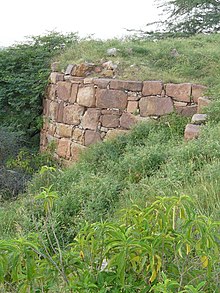
 The bastion of Lal Kot fort, Mehrauli, Delhi, built by Tomara, a.k.a. TanwarGurjar ruler, Anangpal in c. AD 736.
The bastion of Lal Kot fort, Mehrauli, Delhi, built by Tomara, a.k.a. TanwarGurjar ruler, Anangpal in c. AD 736.
(Village Anangpur, a Gurjar village is not far away from Rai Pithora)
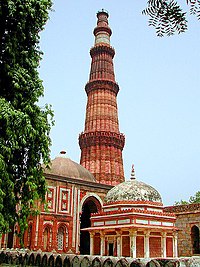
 The Qutub Minar is the world's tallest brick minaret at 72.5 metres, built by Qutb-ud-din Aibak of TurkicSlave dynasty in 1192.
The Qutub Minar is the world's tallest brick minaret at 72.5 metres, built by Qutb-ud-din Aibak of TurkicSlave dynasty in 1192.
The Tomar dynasty founded Lal Kot in 736. The Prithviraj Raso names the Tomar Anangpal as the founder of Lal Kot, whose name is inscribed on Iron Pillar of Delhi at Qutb complex, ascribed to Chandra or Chandragupta II.[15]The Chauhan kings of Ajmer conquered Lal Kot in 1180 and renamed it Qila Rai Pithora.

 Museum and remnants of the walls at Qila Rai Pithora, the first city of Delhi, founded during 10th century by Prithviraj Chauhan
Museum and remnants of the walls at Qila Rai Pithora, the first city of Delhi, founded during 10th century by Prithviraj Chauhan
The Chauhan king Prithviraj III was defeated in 1192 by the Muslim invader Muhammad Ghori.Anangpal Tomar, who, according to historian Augustus Hoernle, was a Gurjar[16] ruler of Delhi, often described as the founder of Delhi, built the citadel some 10 kilometres from Suraj Kund around 731.
From 1206, Delhi became the capital of the Delhi Sultanate under the Slave Dynasty. The first Sultanof Delhi, Qutb-ud-din Aybak, was a former slave who rose through the ranks to become a general, a governor and then Sultan of Delhi. Qutb-ud-din started the construction of the Qutub Minar, a recognisable symbol of Delhi, to commemorate his victory but died before its completion. In the Qutb complex he also constructed the Quwwat-al-Islam (might of Islam), which is the earliest extant mosque in India. He was said to have destroyed twenty-seven Jain temples initially housed in the Qutb complex and pillaged exquisitely carved pillars and building material from their debris for this mosque, many of which can still be seen.[17] After the end of its the Slave dynasty, a succession of Turkic Central Asian and Afghan dynasties, the Khilji dynasty, the Tughluq dynasty, the Sayyid dynasty and the Lodi dynasty held power in the late medieval period and built a sequence of forts and townships in Delhi.[18]In 1398, Timur Lang invaded India on the pretext that the Muslim sultans of Delhi were too tolerant of their Hindu subjects. After defeating the armies of Nasiruddin Mahmud of Tughlaq dynasty, on 15 December 1398, Timur entered Delhi on 18 December 1398, and the city was sacked, destroyed, and left in ruins, and over 100,000 war prisoners were killed as well.[19][20] In 1526, following the First Battle of Panipat, Zahiruddin Babur, the former ruler of Fergana, defeated the last Afghan Lodi sultan and founded the Mughal dynasty which ruled from Delhi, Agra and Lahore.
Places to See in Delhi
INDIA GATE
Rashtrapati Bhawan
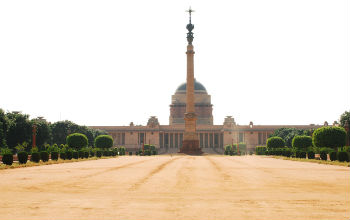 Category : History & Culture Category : History & CultureThe Rashtrapati Bhawan is a renowned monument in Delhi. It is said to be the palace of the then Viceroy of India. At present, the Rashtrapati Bhawan is house of the President of India. The building was designed by Edwin Lutyens. The construction began in 1911 and it took 19 years to finish its construction. There is a wonderful Mughal garden towards the west of Rashtrapati Bhawan. It opens up to public every spring. Tours to Rashtrapati Bhawan and Mughal Gardens are available with a nominal registration fee of Rs.25. Visitors in a group of 30 and more shall be offered discounted rates and children below 12 years will not be charged any fee. More... |
Red Fort (Lal Qila)
Jama Masjid
Gurudwara Sis Ganj Sahib
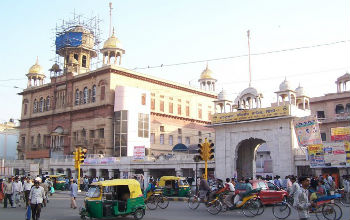 Category : Religious Category : Religious"Unless a holy man lays down his head for the sake of the poor Brahmins, there is no hope for their escape from imperial tyranny". These were the words of a gentle holy man who fiercely fought against the atrocities of the Mughals over Hindus. He became the ninth guru of the Sikhs, Guru Tegh Bahadur Sahib Ji. The brave Guru, who was a symbol of valor and conviction, was beheaded by the Mughal ruler Aurangzeb while protecting the religious faith of the non-Muslims in India. Gurudwara Sis Ganj Sahib is an insignia of the martyrdom of this brave guru. . |
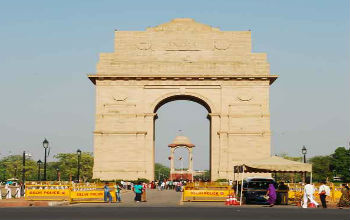
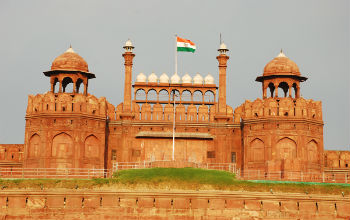
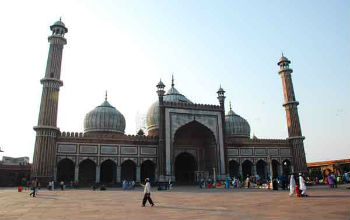
No comments:
Post a Comment